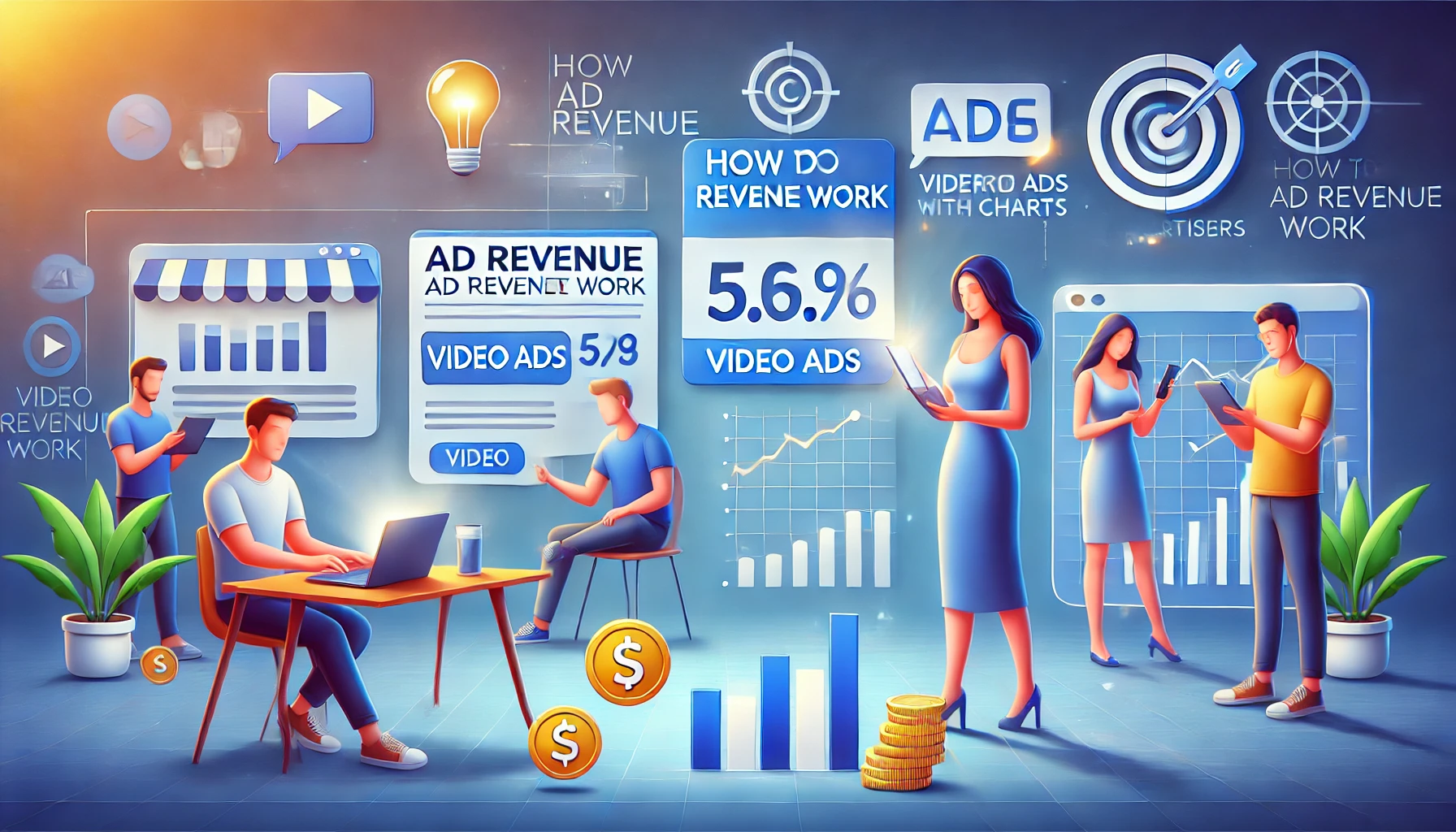Table of Contents
How does ad revenue work, and what strategies ensure success? Ad revenue can transform a digital presence into a thriving business, but understanding the mechanics and methods to maximize profits is crucial.
This article unpacks the foundational principles of ad revenue and provides actionable insights for success.
Understanding How Ad Revenue Works
Ad revenue is a vital aspect of online monetization, enabling content creators, publishers, and platforms to generate income. To maximize its potential, it’s crucial to understand how it works and the mechanisms behind successful revenue generation.
What Is Ad Revenue and Why It Matters
Ad revenue refers to the income earned by displaying ads on digital platforms like websites, social media, or apps. It’s a cornerstone for businesses and creators, offering a consistent way to monetize traffic while delivering value to advertisers.
Ad revenue matters because it powers many free online services, from content publishing to app development. Without ad revenue, many platforms would struggle to sustain their operations or offer free access to users.
For creators and businesses, ad revenue provides a scalable income source. The more traffic or user engagement a platform generates, the higher its earning potential. Understanding this dynamic is crucial for sustained growth.
Advertisers benefit, too, as ad revenue models allow them to reach targeted audiences effectively. These systems ensure mutually beneficial relationships between publishers and advertisers.
Additionally, ad revenue promotes competition and innovation. Platforms constantly improve user experience and ad delivery to optimize earnings while satisfying their audience.
Key Players in the Ad Revenue Ecosystem
The ad revenue ecosystem consists of publishers, advertisers, ad networks, and users. Each player has a distinct role, and understanding this interplay is essential for maximizing ad revenue potential.
Publishers are platforms hosting ads, such as websites or apps. They rely on engaging content and significant traffic to attract advertisers. Their role involves balancing ad placement with user experience.
Advertisers create campaigns to promote products or services. They aim to reach targeted audiences through various ad formats, paying publishers or ad networks based on performance metrics.
Ad networks act as intermediaries, connecting publishers with advertisers. Platforms like Hilltopads simplify the ad revenue process by automating ad placement, pricing, and reporting.
Users are the final link. Their interaction with ads—whether through clicks, impressions, or purchases—drives revenue. Platforms must prioritize user satisfaction to maintain traffic and engagement.
By working together, these players form a sustainable ad revenue model. Platforms thrive when this ecosystem is well-balanced and optimized.
The Process of Generating Ad Revenue
Generating ad revenue begins with setting up a platform capable of hosting ads, such as a blog, app, or video channel. The process involves attracting traffic, displaying ads, and earning income through various monetization methods.
First, traffic generation is critical. Platforms need a steady flow of visitors to ensure ads are seen. This is achieved through SEO, social media marketing, and content creation tailored to audience interests.
Next, ads are displayed using ad networks or direct partnerships with advertisers. Common models include pay-per-click (PPC), where revenue is earned per ad click, or cost-per-mille (CPM), based on impressions.
Revenue optimization involves analytics and testing. Monitoring click-through rates (CTR) and engagement helps platforms refine ad placement, formats, and targeting to maximize earnings.
Finally, payments are processed, often on a monthly cycle. Earnings depend on factors like ad type, traffic volume, and audience engagement, making consistent improvement essential for sustained growth.
Types of Ad Revenue Models
Ad revenue models include various methods to earn income from ads. Understanding these models helps platforms choose the best fit for their audience and objectives.
The pay-per-click (PPC) model generates revenue when users click on ads. It’s effective for platforms with engaged audiences and encourages advertisers to create compelling campaigns.
Cost-per-mille (CPM) models pay publishers based on ad impressions. Platforms earn a fixed amount per 1,000 views, making it suitable for high-traffic websites with broad reach.
Cost-per-acquisition (CPA) focuses on user actions, such as purchases or sign-ups. While earning potential is higher, it requires platforms to drive high-quality leads for advertisers.
Programmatic advertising automates ad placement using AI, optimizing revenue by targeting ads to specific audience segments. It’s a growing trend in ad revenue.
Native advertising integrates ads seamlessly into content, enhancing user experience. It’s effective for publishers aiming to monetize without disrupting their audience.
Each model has strengths and challenges, making it essential to align ad strategies with audience behavior and platform goals.
Proven Strategies to Maximize Ad Revenue

To boost ad revenue effectively, you need strategies that combine creative ad placement, audience targeting, and constant testing. These proven methods ensure you maximize your earning potential while delivering value to advertisers and a seamless experience to users.
Identifying High-Converting Ad Formats
Choosing the right ad formats is essential to increase revenue and engagement. High-converting ad formats, like native ads, video ads, and interactive banners, appeal to users while meeting advertiser objectives. Let’s explore how you can identify the best options.
Native ads blend seamlessly with content, creating a non-intrusive experience. I suggest using these for blogs or platforms with heavy text-based content. Their ability to match the platform’s tone often results in higher engagement rates.
Video ads are particularly effective for social media or content-rich sites. If you’re focusing on platforms like YouTube or Instagram, these can generate significant ad revenue. Make sure your videos are engaging and relevant to your audience’s interests.
Interactive banners and carousel ads are excellent for e-commerce sites. These ads allow users to engage directly with products, boosting click-through rates (CTR). Test these formats to see how they perform in your niche.
Identify ad formats by analyzing your audience’s preferences. I recommend studying engagement metrics like CTR and dwell time to determine what works best. Use A/B testing to refine choices further for optimal results.
Optimizing Content for Ad Placement
Strategic ad placement can significantly influence revenue. When you optimize content to align with user behavior, ads become more engaging and less disruptive. Here’s how you can achieve it effectively.
Start by analyzing your site layout. Ads placed near the fold, where users naturally pause while scrolling, often perform better. I suggest placing banners or native ads here to capture attention without overwhelming the user.
Incorporate ads into content sections. For example, using mid-content ads within blog posts can increase visibility. Ensure they’re contextually relevant to the content, making them feel like a natural extension of the reading experience.
Responsive design is crucial for mobile users. Ad revenue can drop if your ads don’t display properly on smaller screens. Optimize for all devices to maintain a seamless user experience across platforms.
Track performance regularly. Use heatmaps to understand where users spend the most time. Adjust your ad placement strategy based on these insights to continuously improve results.
How Targeting Enhances Ad Revenue
Targeting ensures that ads are shown to the right audience, maximizing relevance and profitability. Understanding your audience’s demographics, behavior, and preferences can help fine-tune ad targeting for better engagement and revenue.
Demographic targeting focuses on age, gender, location, or income levels. For instance, if your content caters to young professionals, I recommend choosing ads that align with their lifestyle or career needs for higher click-through rates.
Behavioral targeting uses browsing history and user activity to predict interests. Incorporating this approach can personalize the ad experience, making users more likely to engage. Platforms like Google Ads simplify this process with automated tools.
Contextual targeting matches ads to content topics. For example, if you’re running a fitness blog, ads for workout gear or nutrition supplements will feel relevant and valuable to your audience. This approach enhances the user experience.
Retargeting, or showing ads to users who’ve previously interacted with your site, can boost conversions. I advise using retargeting ads to re-engage potential customers and maximize ad revenue efficiently.
A/B Testing for Better Ad Performance
A/B testing, or split testing, compares two variations of an ad or strategy to determine what works best. It’s a powerful tool to optimize ad performance and refine your revenue strategies effectively.
Test ad formats by running variations like static banners versus video ads. Monitor key metrics such as CTR and conversion rates to determine which format resonates most with your audience.
Experiment with placement. For instance, compare the performance of ads at the top of the page versus within content. Small changes can yield significant improvements in user engagement and ad revenue.
Optimize messaging by testing different headlines, call-to-action phrases, or visuals. I recommend focusing on elements that directly impact user decisions, ensuring each change is measurable and actionable.
Set clear goals for each test. Whether you’re improving CTR, reducing bounce rates, or increasing conversions, having a focused objective ensures meaningful insights from your A/B tests.
Key Factors Influencing Ad Revenue
Ad revenue depends on several critical factors, from traffic quality to user engagement. Understanding these elements and how they interact can help you develop better strategies to maximize earnings and maintain long-term monetization success.
The Role of Traffic Volume and Quality
Traffic is a key driver of ad revenue, but not all traffic is created equal. High-quality, engaged visitors often generate more income than sheer numbers. Here’s how to balance volume and quality for maximum impact.
Quality traffic involves visitors who actively engage with your content. I recommend focusing on audiences genuinely interested in your niche, as they’re more likely to interact with ads and increase conversion rates.
Generating high traffic starts with great content. SEO strategies, such as keyword optimization and link building, help attract targeted visitors. Pair this with social media promotion to bring in diverse, interested audiences.
Organic and direct traffic often perform better for ad revenue. These visitors usually have higher intent, increasing the likelihood of engagement. Study your analytics to identify these sources and prioritize them.
Use tools like Monsterinsights to monitor visitor behavior. Metrics such as bounce rate and session duration offer insights into traffic quality, helping you fine-tune strategies for improved revenue.
How User Engagement Impacts Revenue
Engaged users are a cornerstone of ad revenue. When visitors interact with your site and its ads, the likelihood of generating income increases. Let’s explore actionable ways to improve user engagement for higher earnings.
Interactive content keeps users invested. I suggest incorporating quizzes, polls, or videos to captivate your audience. These elements not only boost engagement but also create more opportunities for ad clicks or impressions.
Page load speed affects user retention. Slow-loading pages can frustrate visitors, decreasing interaction. Optimize your site to improve speed, as this can significantly influence engagement rates and revenue potential.
Create a user-friendly design with clear navigation. When visitors can easily explore your site, they’re more likely to spend time browsing, increasing ad exposure. A seamless experience always enhances engagement.
Monitor engagement metrics like average time on page and scroll depth. These insights reveal how users interact with your content, allowing you to make adjustments that drive better engagement and ad performance.
The Importance of Relevancy in Ads
Relevance is vital for ad success. Users are more likely to engage with ads that resonate with their interests or needs. Here’s how you can ensure your ads stay relevant and maximize their impact.
Contextual ads match your content, creating a natural experience. For instance, ads for fitness gear on a workout blog feel more relevant than generic banners. I advise aligning ads with your audience’s preferences.
Behavioral targeting customizes ads based on user activity. Platforms like Google Ads use browsing history to display ads tailored to each visitor, making them more engaging and effective.
Dynamic ad formats adjust based on real-time factors like location or time of day. These personalized touches can make ads feel directly relevant, increasing click-through rates and revenue potential.
Regularly review ad performance data to spot trends in user engagement. I recommend removing underperforming ads and focusing on those that align well with your audience’s behavior and interests.
Ad Blockers and Their Effect on Revenue
Ad blockers can reduce revenue significantly by preventing ads from displaying. While they pose challenges, there are strategies to mitigate their impact and maintain steady income streams.
Educate your audience on the role of ads. Explain that ads support free content, encouraging visitors to whitelist your site. A clear and friendly message can foster understanding and cooperation.
Offer non-intrusive ad formats. Avoid aggressive pop-ups or autoplay videos, as these can push users toward ad blockers. Instead, use native ads or sponsored content for a less intrusive experience.
Diversify monetization methods. Affiliate marketing, sponsored posts, or subscription models can supplement ad revenue. I suggest experimenting with alternative strategies to reduce reliance on ads alone.
Monitor the percentage of users with ad blockers using analytics tools. This helps assess the scale of the issue and implement solutions that preserve user trust while maintaining revenue.
Exploring Ad Revenue Platforms

Choosing the right ad revenue platform is a critical step in monetization. Platforms like Google AdSense or programmatic advertising networks offer unique advantages, allowing you to optimize earnings based on your goals and audience.
Overview of Google AdSense and Competitors
Google AdSense is a popular choice for monetizing websites, but competitors like Media.net and Raptive also provide viable options. Let’s explore how these platforms differ and their potential for maximizing revenue.
Google AdSense is user-friendly, making it ideal for beginners. It uses an automated process to display ads relevant to your audience, ensuring consistency and ease of use. I recommend this as a starting point for most publishers.
Media.net specializes in contextual ads, aligning perfectly with niche blogs or websites. This platform works well if your audience values relevancy and high-quality ad placements, ensuring a balanced user experience.
Raptive caters to content-rich sites with significant traffic. While its requirements are higher, the platform provides premium ads with better rates. Consider this if you’re ready to scale your ad revenue strategy.
Experiment with multiple platforms. Testing alternatives can reveal which generates the best revenue while maintaining a positive user experience. Always prioritize options that align with your audience and goals.
Choosing the Right Ad Network for Your Niche
Ad networks vary based on niche, traffic type, and audience. Selecting the best one ensures optimal ad revenue while meeting your site’s unique needs. Here’s how to make an informed decision.
Assess your niche’s compatibility with the ad network. For instance, e-commerce sites might benefit from networks like Shopify Ads, while bloggers might prefer Google AdSense or Mediavine. Tailor your choice to your audience.
Consider traffic volume and quality. Smaller sites may start with simpler networks like Ezoic, while high-traffic platforms can leverage premium networks offering better CPM rates. I recommend scaling as your traffic grows.
Evaluate network requirements. Platforms like Mediavine or AdThrive have stricter entry criteria, but they often deliver higher earnings. Check whether your site meets these conditions before applying.
Review payment terms and support. Choose networks that offer flexible payment options and strong customer support. These factors can make a significant difference in your experience as a publisher.
Programmatic Advertising and Its Benefits
Programmatic advertising automates the ad buying process, using AI to match ads with the right audience. This efficient method can increase ad revenue while reducing manual effort for publishers.
Programmatic advertising optimizes targeting. Using data-driven algorithms, ads are displayed to users most likely to engage, increasing both CTR and conversion rates. It’s a win-win for publishers and advertisers.
Real-time bidding (RTB) is a key feature of programmatic platforms. Advertisers bid for ad space in real-time, ensuring publishers earn the highest possible revenue for each impression. I suggest exploring this for better rates.
Platforms like Google Ad Manager simplify programmatic advertising. These tools streamline the process, making it accessible even for beginners. You can use them to test and scale your strategies effectively.
Focus on transparency. Understand how your ad revenue is generated through programmatic methods. Clear reporting and analytics are essential for refining strategies and optimizing income.
Maximizing Revenue Through Affiliate Ads
Affiliate ads offer a unique way to earn revenue, rewarding publishers for driving sales or leads. Integrating these ads with traditional ad revenue strategies can create a diversified, robust income stream.
Choose affiliate programs relevant to your niche. For example, a tech blog might promote software, while a fitness site could recommend workout gear. I suggest aligning affiliate offers with your audience’s interests.
Embed affiliate links naturally within content. For instance, a product review can feature links to recommended items, making the ad feel helpful rather than intrusive. This approach improves both user experience and conversions.
Leverage seasonal promotions. Affiliate networks often run exclusive deals during holidays or events. Promoting these offers can significantly boost your earnings while providing value to your audience.
Track performance using analytics. Identify which affiliate ads generate the most clicks or sales. Refine your strategy based on these insights, focusing on high-performing campaigns for better results.
Advanced Tips to Boost Ad Revenue
Advanced strategies can significantly enhance how ad revenue works for your platform. By leveraging analytics, improving SEO, and balancing user experience, you can unlock the full potential of your monetization efforts and drive sustained growth.
Leveraging Analytics to Refine Strategies
Analytics offer critical insights into ad performance, user behavior, and site traffic. Using data effectively helps you refine your strategies to maximize ad revenue while maintaining a user-friendly experience tailored to audience preferences.
Start with tools like Google Analytics. These provide essential metrics such as click-through rates (CTR), conversion rates, and bounce rates. I recommend tracking these regularly to identify what works and where adjustments are needed.
Heatmaps reveal user behavior, showing where they interact most on your site. Use this data to optimize ad placements in high-engagement areas, ensuring ads are seen without disrupting the user’s journey.
Segment your audience for detailed insights. Understanding different user groups—such as new visitors versus returning ones—allows you to create targeted ad strategies that cater to specific preferences and behaviors.
Set measurable goals for improvement. Whether you’re aiming for a 10% increase in CTR or higher engagement rates, clear objectives ensure your analytics drive actionable changes that boost revenue.
The Power of SEO in Driving Ad Revenue
SEO plays a crucial role in how ad revenue works, as higher search rankings attract more traffic. Optimizing your site for relevant keywords and user intent helps ensure consistent growth and better ad performance.
Use keyword research tools to identify high-value terms. I suggest integrating these keywords naturally into your content, ensuring they align with your audience’s interests and search behavior for improved visibility.
Create high-quality, evergreen content. Well-researched articles or guides keep attracting traffic over time, providing consistent ad impressions and revenue opportunities. Pair this with regular updates to maintain relevance.
Optimize your site’s technical SEO. Fast loading speeds, mobile responsiveness, and proper indexing contribute to better search rankings. These factors also enhance user experience, boosting engagement and ad interactions.
Focus on building backlinks from reputable sites. Strong link profiles increase your site’s authority, driving more organic traffic. Higher traffic levels lead to greater ad revenue opportunities, reinforcing the importance of SEO.
Monetizing with Sponsored Content and Partnerships
Sponsored content and strategic partnerships complement traditional ad revenue strategies. These collaborations provide additional income streams while strengthening your brand’s credibility and audience trust.
Identify brands aligned with your niche. For example, if your platform focuses on health, partnering with wellness companies ensures relevance. I recommend approaching brands with mutual goals for a successful partnership.
Create authentic sponsored content. Sponsored posts or videos should integrate naturally into your platform, offering value to your audience. Avoid overly promotional tones, as these can harm credibility and user trust.
Leverage affiliate partnerships. Affiliate programs allow you to earn commissions on sales generated through your platform. Choose products or services that resonate with your audience to increase conversions and revenue.
Use analytics to measure the success of these efforts. Tracking metrics such as engagement, conversions, or referral sales helps you refine sponsored content strategies and optimize future collaborations.
Balancing User Experience with Ad Density
Ad density directly affects user experience. Too many ads can overwhelm visitors, while too few may limit revenue. Striking the right balance is key to maintaining engagement and maximizing how ad revenue works effectively.
Evaluate your current ad placements. I suggest analyzing performance data to identify underperforming ads or placements that disrupt user navigation. Removing these can improve user satisfaction.
Focus on non-intrusive ad formats. Native ads, for instance, blend seamlessly with content, offering value without interrupting the user’s experience. This approach often results in higher engagement and revenue.
Use frequency capping to control ad exposure. Showing the same ad repeatedly can frustrate users. Limiting the number of impressions per user helps maintain a positive experience while preserving ad effectiveness.
Test different layouts to find the optimal configuration. A/B testing can reveal whether certain placements or formats lead to better engagement, allowing you to fine-tune your strategy and keep users happy.
Common Challenges and How to Overcome Them

Ad revenue models come with challenges, from seasonal fluctuations to low CTRs. Identifying these issues and implementing targeted solutions ensures stable earnings while maintaining a positive user experience on your platform.
Dealing with Seasonal Revenue Fluctuations
Seasonal changes can impact ad revenue, with demand and traffic varying throughout the year. Planning ahead and diversifying revenue streams help mitigate these effects and maintain consistent income.
Analyze historical trends to anticipate fluctuations. I recommend reviewing previous data to identify patterns and adjust your strategy during high- and low-demand seasons effectively.
Create seasonal content to align with trends. For instance, holiday-themed articles or promotions can boost traffic and revenue during peak periods. Pair this with relevant ad placements to maximize earnings.
Diversify your income sources. Incorporating affiliate marketing, sponsored content, or premium subscriptions ensures you’re not solely reliant on ad revenue during slower periods.
Communicate with advertisers about seasonal campaigns. Building long-term relationships allows for better planning and collaboration, ensuring both parties benefit regardless of demand changes.
Tackling Low Click-Through Rates (CTR)
Low CTRs hinder ad revenue potential. Addressing this issue involves improving ad quality, placement, and targeting to encourage more user interactions and better engagement.
Design visually appealing ads. High-quality graphics and clear calls to action often result in higher CTRs. I advise collaborating with advertisers to ensure ad designs align with your audience’s preferences.
Test different ad formats. Interactive or video ads may perform better than static banners, depending on your audience. Experimenting with various formats helps identify what works best for your platform.
Refine targeting strategies. Displaying ads to the right audience is crucial. Behavioral and contextual targeting can improve relevance, encouraging users to engage and boosting CTRs effectively.
Track performance metrics and adjust as needed. Monitoring engagement rates reveals underperforming ads, allowing you to make informed decisions about replacements or strategy changes.
Overcoming Competition in Ad Revenue Space
The ad revenue space is highly competitive. Standing out requires unique content, strong audience connections, and innovative monetization strategies to thrive amidst growing competition.
Focus on niche expertise. Creating specialized content positions you as an authority, attracting a loyal audience and advertisers looking for targeted opportunities.
Invest in branding to differentiate yourself. A clear, consistent voice and design build trust with your audience, making your platform more attractive to advertisers seeking premium placements.
Leverage data to offer advertisers value. Demonstrating detailed insights about your audience—like demographics or preferences—can set you apart from competitors with less specific information.
Explore unique ad formats or partnerships. Thinking creatively about monetization ensures you’re offering something distinct, keeping your revenue streams robust and diversified.
Maintaining Credibility While Monetizing
Balancing monetization with credibility is vital for long-term success. Overloading users with ads can erode trust, so maintaining authenticity while pursuing revenue growth is essential.
Ensure transparency with your audience. Clearly label sponsored content or affiliate links, building trust and avoiding confusion about the nature of your ads.
Prioritize quality over quantity. Fewer, high-quality ads often perform better than an overwhelming number, preserving both user experience and platform integrity.
Avoid deceptive practices like clickbait ads. These harm credibility and can lead to higher bounce rates. I suggest partnering only with advertisers aligned with your values and audience expectations.
Solicit user feedback about your monetization strategy. Engaging directly with your audience ensures you’re meeting their needs while optimizing for ad revenue in a way that feels authentic and respectful.
Future Trends in Ad Revenue Models
Ad revenue is evolving, with emerging technologies and shifts in consumer behavior reshaping the landscape. Staying ahead of these trends ensures your strategies remain relevant and effective in a competitive environment.
The Rise of AI and Machine Learning in Ads
AI-driven tools optimize ad targeting, placement, and design, revolutionizing how ad revenue works. Embracing these technologies allows for smarter decisions and improved performance metrics.
Machine learning algorithms enhance targeting precision. Platforms can analyze vast amounts of data to predict user behavior, ensuring ads reach the most relevant audience for higher engagement.
AI streamlines ad creation. Tools like automated design systems generate visually appealing ads quickly, helping publishers and advertisers save time while maintaining quality.
Predictive analytics improve strategy planning. By forecasting trends, AI enables you to adjust campaigns proactively, maximizing revenue during peak periods or mitigating downturns.
Ethical considerations matter. As AI becomes integral to advertising, transparency and user consent ensure trust and compliance with privacy standards, preserving your platform’s credibility.
Personalized Advertising and Its Impact
Personalized advertising tailors ads to individual preferences, creating more meaningful interactions. This approach enhances how ad revenue works by increasing engagement and improving conversion rates, making it a key strategy for future growth.
Personalized ads rely on data such as browsing history, purchase behavior, or demographic information. By analyzing this data, platforms deliver ads that resonate with users, leading to higher click-through rates (CTR) and better performance overall.
Dynamic content is central to personalization. Ads that adapt in real time—like showcasing local offers or relevant products—create a more engaging experience. I suggest integrating dynamic ads to boost relevance and user interest.
Respecting privacy is crucial. While personalization can improve ad effectiveness, transparent data practices and user consent are essential. Build trust with your audience by clearly communicating how their data is used.
Testing personalized ad strategies ensures they deliver the desired results. Use analytics tools to monitor performance and refine your approach, focusing on strategies that align well with your audience’s preferences.
Emerging Revenue Opportunities in Video Ads
Video ads are transforming the advertising landscape. As users consume more video content, leveraging this format effectively enhances how ad revenue works while offering advertisers a dynamic way to connect with audiences.
Short-form video ads, such as those on platforms like YouTube or TikTok, capture attention quickly. These ads perform well in mobile-first environments, providing high engagement rates without disrupting the user experience.
Interactive video ads encourage user participation. For instance, clickable elements within videos allow users to explore products directly, creating a seamless path to conversion. I recommend testing these for e-commerce platforms.
In-stream ads offer non-intrusive placements. Ads that play during natural breaks in video content often feel less disruptive, making them more effective for platforms prioritizing user experience.
Focus on quality production. Well-crafted video ads with compelling visuals and messaging engage viewers better. Partnering with experienced creators ensures your video content resonates with your audience and achieves its goals.
How Sustainability Affects Ad Revenue Strategies
Sustainability is becoming a major factor in ad revenue models. Aligning with eco-friendly practices and values helps platforms appeal to conscious consumers while building long-term trust and loyalty.
Eco-conscious ads resonate with audiences prioritizing sustainability. I advise collaborating with brands that align with these values, showcasing products or services committed to environmental responsibility.
Reduce the environmental impact of digital ads. Initiatives like green hosting or optimizing ad delivery for energy efficiency contribute to sustainability while supporting your platform’s credibility.
Transparency about sustainability efforts builds trust. Highlighting your commitment to eco-friendly practices in your messaging creates a stronger connection with your audience and differentiates your platform.
Stay informed about industry trends in sustainability. As consumers and advertisers increasingly prioritize these issues, incorporating sustainable practices into your ad strategies ensures your platform stays competitive.






